Updated on
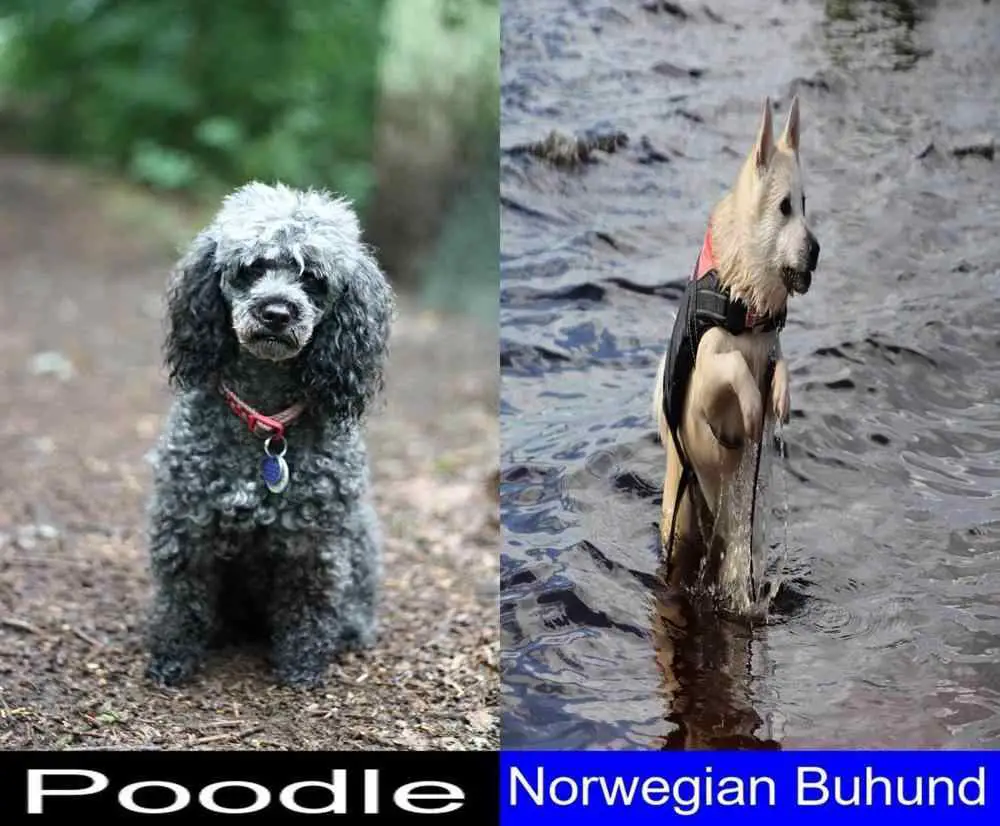
Quick Links: Table of Contents
- Poodle Versus Norwegian Buhund: Introduction
- Poodle versus Norwegian Buhund: Overview
- Poodle versus Norwegian Buhund: Comparison Table
- The Most Remarkable Differences Between the Poodle and the Norwegian Buhund
- The Similarities Between the Poodle and the Norwegian Buhund
- The Popularity of Poodle versus Popularity of Norwegian Buhund
- Health Problems of Poodle versus Health Problems of Norwegian Buhund
- Tolerates Being Alone: Poodle versus Norwegian Buhund
- Do Poodles shed more than Norwegian Buhunds?
- Which is Easier to Groom, the Poodle or the Norwegian Buhund?
- Which Dog Breed is more Dog-Friendly, the Poodle or the Norwegian Buhund?
- Are Poodles good family dogs? What about Norwegian Buhunds?
- Is the Poodle Easier to Train than the Norwegian Buhund?
- Which one drools more, the Poodle or the Norwegian Buhund
- How Kid-friendly are Poodles and Norwegian Buhunds?
- Does the Poodle Have a Higher Prey Drive than the Norwegian Buhund?
- Do Poodles Bark and Howl? What about Norwegian Buhunds?
- Can Poodles Tolerate Cold Weather? And can Norwegian Buhunds Tolerate Cold Weather?
- Wanderlust Potential: Poodle vs. Norwegian Buhund
- Can Poodles Tolerate Hot Weather? Can Norwegian Buhunds Tolerate Hot Weather?
- Poodle Versus Other Dog Breeds
- Conclusion: Poodle versus Norwegian Buhund. Which One is a Better Pet?
Poodle Versus Norwegian Buhund: Introduction
Are you thinking of getting a new pet dog, and you have narrowed down your choices to the Poodle and the Norwegian Buhund? Well, you have come to the right place. Because in this article, we will provide you with a detailed comparison of these two dog breeds to help you decide which of the Poodle and the Norwegian Buhund better suits you.
We will provide you a detailed discussion and comparison of dog attributes such as intelligence, price, general health, friendliness, etc, for both the Poodle and the Norwegian Buhund.
Furthermore, we will let you know which one of the Poodle and the Norwegian Buhund is better suited for new dog owners, for owners with kids, for owners that live in apartments, for owners with dog allergies, etc.
Importantly, we did some analysis and calculation and we obtained a number that we call the Better-Pet Score™ for both the Poodle and for the Norwegian Buhund. The dog breed with the higher Better-Pet score is the `better` pet. We hope that these Better-Pet Scores will provide you with more insight into deciding which pet to get between the Poodle and the Norwegian Buhund.
Our only goal here is to help you make a well-thought-out decision on your next long-term companion, be it the Poodle or the Norwegian Buhund.
Note that there are 3 types of Poodles:
However, these 3 poodle `types` are basically the same. The only difference between them is size. Standard Poodles are big, toy poodles are small, and miniature poodles are medium-sized.
Read more about the subtle differences between the standard poodle vs. miniature poodle here and the toy poodle versus miniature poodle here.
In addition, we have articles on the detailed comparisons of the poodle to every other dog breed. Check out our articles on poodle versus other dog breeds here.

Poodle versus Norwegian Buhund: Overview
A very important difference between the Poodle and the Norwegian Buhund is the size difference between the two dog breeds. The Poodle is a large-sized dog while the Norwegian Buhund is a medium-sized dog.
Furthermore, the Poodle belongs to the Companion Dogs group. Companion Dogs were bred to be companions for humans. Their main goal in life is to be with people, and they will be very sad if left to themselves for long hours day after day.
On the other hand, the Norwegian Buhund belongs to the Herding Dogs group. Herding Dogs were bred for moving livestock, including sheep, cattle, and even reindeer. Herding dogs work closely with their human shepherds, and their natural intelligence and responsiveness make them highly trainable. They have high levels of energy, which needs to be channeled properly to prevent destructive behavior. Herding breeds are protective of their people and property and make excellent watchdogs. Their intelligence, agility, and activity level make them well suited to dog sports.
Poodle versus Norwegian Buhund: Comparison Table
The table below compares the Poodle to the Norwegian Buhund based on different important factors such as Price, Health, Kid-friendliness, etc.
When a dog breed scores higher for a factor than the other dog breed, the box of the breed that scores higher is shaded green and the box of the breed that scores lower is shaded red. When there is no difference between the breeds for a particular factor then the box is shaded gray for both pets. Also, when the factor is not important in picking a pet, or when the factor cannot be compared between two pets, the box for the factor is shaded gray for both pets
Most of the factors in the table for each dog breed are ranked on a scale of 1 to 5. “1” means “worst”, and “5” means “best”.
However, some factors such as “Price”, “Average Lifespan”, etc. cannot be on a scale of 1 to 5, so they are not on a scale of 1 to 5 in the comparison table.
Later in this article, we will further explain each factor as it applies to the Poodle and the Norwegian Buhund
| Factor | Poodle | Norwegian Buhund |
|---|---|---|
| Tolerates Being Alone | 1/5 | 4/5 |
| Does NOT Shed | 5/5 | 3/5 |
| Does NOT Drool | 5/5 | 5/5 |
| Easy To Groom | 1/5 | 2/5 |
| Life Span | 12 to 15 years | 12 to 15 years |
| General Health | 2/5 | 4/5 |
| Low Prey Drive | 4/5 | 4/5 |
| Does NOT Bark or Howl | 4/5 | 2/5 |
| Tolerates Cold Weather | 3/5 | 5/5 |
| Tendency NOT to Wander | 3/5 | 2/5 |
| Calmness/ Low Vigor | 3/5 | 2/5 |
| Weight | 26 to 40 pounds | |
| Easygoing | 2/5 | 3/5 |
| Tolerates Hot Weather | 4/5 | 2/5 |
| Dog Friendly | 4/5 | 3/5 |
| Friendly Toward Strangers | 4/5 | 3/5 |
| Potential NOT to Gain Weight | 2/5 | 3/5 |
| Does NOT chew on things | 2/5 | 3/5 |
| NOT Rambunctious | 2/5 | 2/5 |
| Minimal Exercise Needs | 2/5 | 1/5 |
| Adapts Well To Apartment Living | 5/5 | 3/5 |
| Good For Novice Owners | 5/5 | 3/5 |
| Affectionate With Family | 5/5 | 5/5 |
| Kid-Friendly | 5/5 | 5/5 |
| Easy To Train | 5/5 | 4/5 |
| Intelligence | 5/5 | 3/5 |
| Potential For Playfulness | 5/5 | 5/5 |
| Height | 16 to 18 inches tall at the shoulder | |
| Average Lifespan | 13.5 years | 13.5 years |
| Average Price | No Data | |
| Price Range | No Data | |
| Common Health Problems and Recommended Health Tests | ||
| Popularity out of 200 Dog Breeds | 6 | 168 |
Next, we added the scores of the factors that can be added together for the Poodle in the table (that is, `Ease of Grooming` score + `General Health` score + `Calmness` score + …etc) and we compared it to the corresponding total score for the Norwegian Buhund. We call these total scores the Better-Pet Scores, as we mentioned earlier. We called this score the Better-Pet score because the better dog breed will have a higher score. This is because the pet will the higher score will have minimal needs and be easier to have as a pet.
The Better-Pet score for the Poodle is 88 out of 125 while the Better-Pet score for the Norwegian Buhund is 81 out of 125.
Based on their Better-Pet scores, the Poodle is a better pet than the Norwegian Buhund. So, you should get a Poodle!
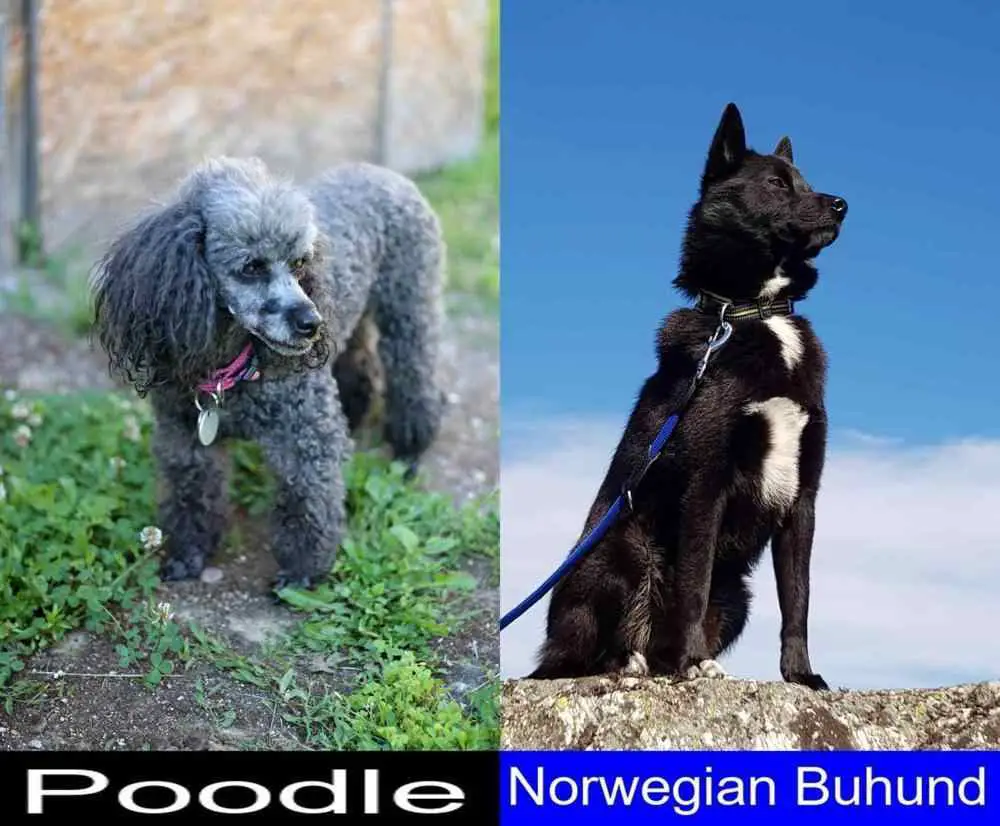
The Most Remarkable Differences Between the Poodle and the Norwegian Buhund
Below is a list of where the Poodle and the Norwegian Buhund are most different:
The Similarities Between the Poodle and the Norwegian Buhund
The Poodle and the Norwegian Buhund are very similar in certain aspects. Below is the list of where the Poodle and the Norwegian Buhund are most similar:
Size (Weight and Height) of Poodle versus Norwegian Buhund
Now, let us discuss the difference in size between the Poodle and the Norwegian Buhund.
Poodles come in three main size categories. These three size categories are referred to as the three varieties of the poodle. Poodles of different varieties are basically the same except for their size differences. The poodle varieties based on size categorization are:
There is another variety of poodle that is not recognized in the USA but is recognized in Europe. This poodle size variety is called the Moyen Poodle. In size, the Moyen Poodle is smaller than the Standard poodle but bigger than the miniature poodle.
See below the figure that compares the different poodle sizes:
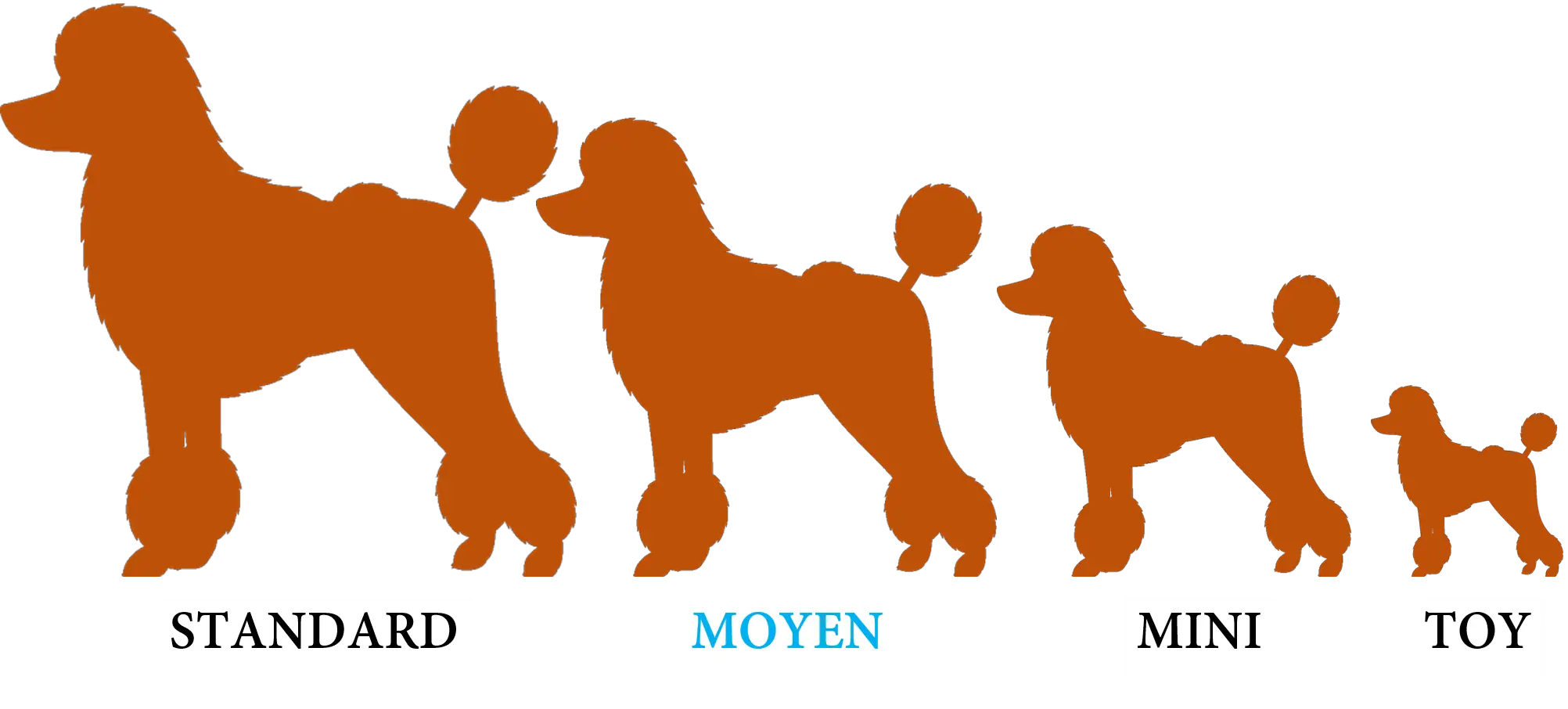
On the other hand, Norwegian Buhunds weigh 26 to 40 pounds when fully grown. Norwegian Buhunds are 16 to 18 inches tall at the shoulder when fully grown.
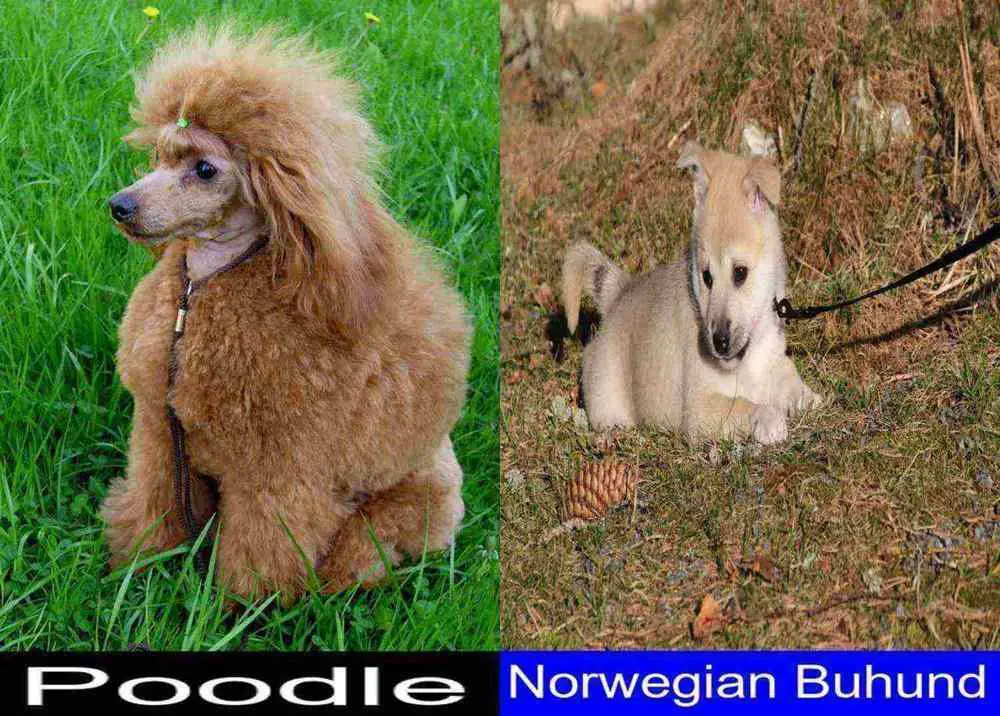
The Popularity of Poodle versus Popularity of Norwegian Buhund
Every year, the American Kennel Club (AKC) publishes information on how popular a dog breed is in that particular year. The AKC gets the popularity information of a breed from how many dogs of that breed the owners register with the AKC every year. The AKC collects this data for about 200 dog breeds. The AKC collects this data for purebred dogs only(no mixed or hybrid dogs).
The graphs and the table below show the popularity of the Poodle and the Norwegian Buhund over the years.
Based on the AKC popularity data over the years, the Poodle is more popular with dog owners than the Norwegian Buhund. This is because, over the years, the average popularity of the Poodle is 6 out of about 200 dog breeds while the average popularity of the Norwegian Buhund is 168 out of about 200 dog breeds.
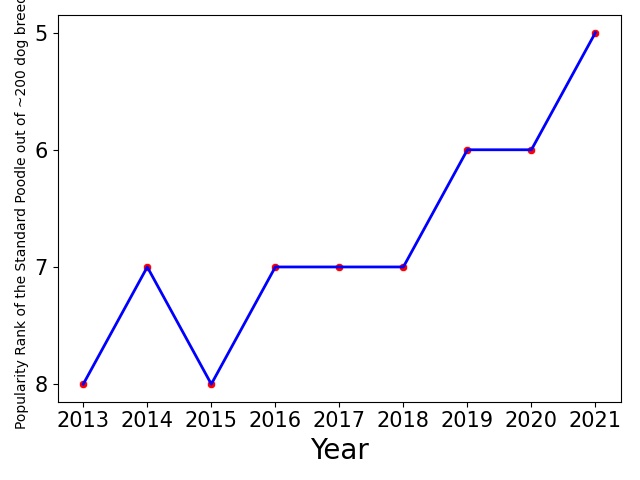
Popularity of Poodle
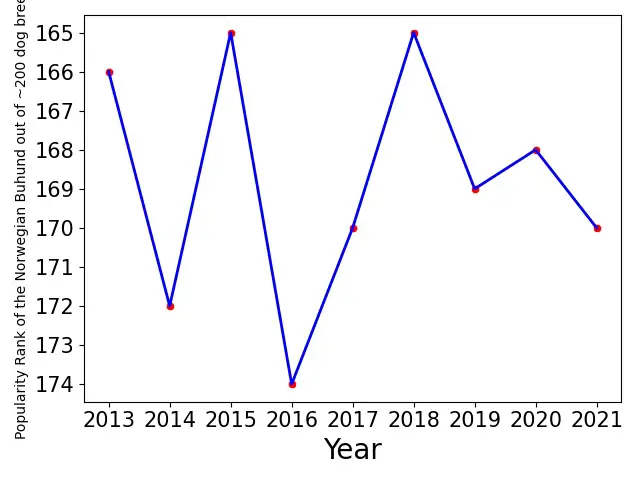
Popularity of Norwegian Buhund
| Year | Standard Poodle Popularity Rank | Norwegian Buhund Popularity Rank |
|---|---|---|
| 2013 | 8 | 166 |
| 2014 | 7 | 172 |
| 2015 | 8 | 165 |
| 2016 | 7 | 174 |
| 2017 | 7 | 170 |
| 2018 | 7 | 165 |
| 2019 | 6 | 169 |
| 2020 | 6 | 168 |
| 2021 | 5 | 170 |
Health Problems of Poodle versus Health Problems of Norwegian Buhund
Every dog breed has its own set of health problems that it has a tendency to develop. There is nothing like a perfect dog breed.
Both the Poodle and the Norwegian Buhund are prone to certain genetic health conditions. The Orthopedic Foundation for Animals (OFA) is the organization that keeps track of health problems in dogs. Based on the extensive records that the OFA keeps, the OFA knows what health problems each dog breed is naturally prone to develop. Hence, the OFA recommends which health screening that breeders should perform on a dog breed to make sure that the breeders won`t breed `defective` dog parents that can pass down defective genes to their puppy offspring.
The more health problems a dog breed is prone to develop, the more health tests the OFA will recommend for that dog breed.
Based on our review of OFA records, we found that the Poodle is prone to more genetic health problems than the Norwegian Buhund.
This is because the OFA recommends more screening health tests for the Poodle than for the Norwegian Buhund.
4 health tests are recommended for Poodle while 3 tests are recommended for the Norwegian Buhund.
Below is a detailed discussion of health problems in Poodles and in Norwegian Buhunds.
Poodle Health Problems
Poodles are genetically prone to certain health problems. However, breeders can reduce the chances of producing Poodle puppies with genetic defects by making sure that a puppy`s parents are free from genetic health problems before allowing the parent to make puppies.
The OFA provides breeders recommendations on which genetic diseases that breeders should screen their dog parents and puppies for.
If you want a Poodle puppy that will grow up to be healthy, make sure that your Poodle breeder screens your puppy or your puppy`s parents for the health problems that the OFA recommends for your puppy`s breed. This will increase the chances that your puppy is free from genetic defects.
The following are the health tests that Orthopedic Foundation for Animals (OFA) recommends that breeders should screen Poodles for:
You can find out more about OFA`s recommended tests for Poodles here.
Norwegian Buhund Health Problems
Norwegian Buhunds are genetically prone to certain health problems. However, breeders can reduce the chances of producing Norwegian Buhund puppies with genetic defects by making sure that a puppy`s parents are free from genetic health problems before allowing the parent to make puppies.
The OFA provides breeders recommendations on which genetic diseases that breeders should screen their dog parents and puppies for.
If you want a Norwegian Buhund puppy that will grow up to be healthy, make sure that your Norwegian Buhund breeder screens your puppy or your puppy`s parents for the health problems that the OFA recommends for your puppy`s breed. This will increase the chances that your puppy is free from genetic defects.
The following are the health tests that Orthopedic Foundation for Animals (OFA) recommends that breeders should screen Norwegian Buhunds for:
You can find out more about OFA`s recommended tests for Norwegian Buhunds here.
More Discussions on Health Problems in Poodles and Norwegian Buhunds
Based on our analysis of data from the Orthopedic Foundation for Animals, of all known genetic health problems in dogs, the health problem that is most commonly seen in the Poodle Breed is Basic Cardiac problems.
This is because the Poodle ranks 1 out of 16 dog breeds for Basic Cardiac problems. In fact, in a health test conducted on 270 Poodles, 2 of them had Basic Cardiac problems.
The genetic diseases that were found to commonly occur in Poodles, and how common these diseases are in Poodles relative to other dog breeds, are given below:
Based on our analysis of data from the Orthopedic Foundation for Animals, of all known genetic health problems in dogs, the health problem that is most commonly seen in the Norwegian Buhund Breed is Eyes problems.
This is because the Norwegian Buhund ranks 35 out of 182 dog breeds for Eyes problems. In fact, in a health test conducted on 244 Norwegian Buhunds, 7 of them had Eyes problems.
The genetic diseases that were found to commonly occur in Norwegian Buhunds, and how common these diseases are in Norwegian Buhunds relative to other dog breeds, are given below:
The table below lists the common health problems in Poodle and in Norwegian Buhund and the rank (prevalence), compared to other dogs, of these health problems in the Poodle and the Norwegian Buhund:
| Disease | Poodle Rank | Norwegian Buhund Rank |
|---|---|---|
| Basic Cardiac problems | 1 out of 16 dog breeds | Not Common |
| Neonatal Encephalopathy W/Seizures problems | 1 out of 1 dog breeds | Not Common |
| Sebaceous Adenitis problems | 1 out of 2 dog breeds | Not Common |
| Chondrodystrophy (Cddy) problems | 3 out of 5 dog breeds | Not Common |
| Rcd4 Progressive Retinal Atrophy problems | 4 out of 8 dog breeds | Not Common |
| Von Willebrands problems | 7 out of 15 dog breeds | Not Common |
| Legg-Calve-Perthes problems | 11 out of 40 dog breeds | Not Common |
| Progressive Retinal Atrophy problems | 14 out of 32 dog breeds | Not Common |
| Dentition Database problems | 21 out of 49 dog breeds | Not Common |
| Advanced Cardiac problems | 49 out of 71 dog breeds | Not Common |
| Degenerative Myelopathy problems | 57 out of 70 dog breeds | Not Common |
| Patella problems | 61 out of 145 dog breeds | Not Common |
| Congenital Cardiac problems | 73 out of 159 dog breeds | Not Common |
| Thyroid problems | 84 out of 115 dog breeds | Not Common |
| Elbow problems | 88 out of 144 dog breeds | Not Common |
| Hips problems | 100 out of 198 dog breeds | 131 out of 198 dog breeds |
| Eyes problems | 127 out of 182 dog breeds | 35 out of 182 dog breeds |
*To learn more about each of these diseases, go to OFA.org and search for the disease.
Again, most of these health problems can be prevented through health screening. Responsible breeders screen male and female dog parents for genetic problems. These breeders will only breed dogs that are free of genetic defects. That way, there is little or no chance that their puppies will grow up to have genetic health problems. Always ask a breeder for the list of health tests the breeder screens their dogs for before buying a puppy from such a breeder.
Tolerates Being Alone: Poodle versus Norwegian Buhund
Poodles do not like to be left alone.
Poodles, by nature, are companion dogs. They like and thrive on human companionship more than most dog breeds. Poodles do not like to be left alone. Leaving a poodle alone for more than 4 hours day after day will cause separation anxiety and isolation distress in a poodle. If you plan to get a poodle, make sure you can be around your poodle most of the time, or arrange for a dog walker.
See our article on how long you can leave a poodle alone.
Norwegian Buhunds can be left alone for some time without problems.
Do Poodles shed more than Norwegian Buhunds?
Poodles do not shed a lot. They are good for people with dog allergies.
Although all dogs shed, and poodles are no different in this regard. But poodles shed less than many other breeds of dogs. However, if you own a poodle, you will not have the problem of having balls of dog hair on your couch and over your house. This is because the curly coat of the poodle traps the hair and other things that the poodle sheds. Therefore, people that are allergic to dogs tend to tolerate poodles better.
Check out our articles to learn more on why poodles do not shed, and on standard poodle shedding, and on shedding in toy poodles
Norwegian Buhunds shed moderately.
Which is Easier to Groom, the Poodle or the Norwegian Buhund?
Poodles require a lot of grooming and they are not very easy to groom.
To learn more about how to properly groom a poodle, check out our article on how to groom a poodle.
Learn more on how to take care of a poodle here.
Norwegian Buhunds require a lot of grooming and they are not very easy to groom.
Which Dog Breed is more Dog-Friendly, the Poodle or the Norwegian Buhund?
Poodles get along very well with other dogs.
Poodles get along very well with other dogs. Poodles are very friendly. However, it is up to the other dog to reciprocate the friendliness. Some dog breeds are just unfriendly and aggressive.
Read this article to learn about the dog breeds that get along well with poodle and the dog breeds that do not along with poodles.
Norwegian Buhunds get along fairly well with other dogs.
Are Poodles good family dogs? What about Norwegian Buhunds?
Poodles are great family dogs. They are very affectionate with family.
Poodles make a good addition to a family. They love kids and kids love them.
Learn about standard poodles as family dogs here, and about how family-friendly are toy poodles here..
Norwegian Buhunds are great family dogs. They are very affectionate with family.
Is the Poodle Easier to Train than the Norwegian Buhund?
Poodles are very easy to train.
Poodles are easy to train because they are intelligent and eager to please their owners. However, it is important that you begin training a poodle to make the most out of their natural intelligence. Moreover, training your Poodle should be based on positive reinforcement and repetition. Be sure to give your Poodle praise when he obeys a command and ignores your poodle`s bad behavior.
To learn more, check out our article on how to train a poodle.
Norwegian Buhunds are very easy to train.
Which one drools more, the Poodle or the Norwegian Buhund
Poodles do have a very low tendency to drool.
Norwegian Buhunds do have a very low tendency to drool.
How Kid-friendly are Poodles and Norwegian Buhunds?
Poodles get along well with kids. They are kid-friendly.
Norwegian Buhunds get along well with kids. They are kid-friendly.
Does the Poodle Have a Higher Prey Drive than the Norwegian Buhund?
Poodles have a very low prey drive. This means they get won`t chase after smaller pets. They tend to get along well with other pets.
Norwegian Buhunds have a very low prey drive. This means they get won`t chase after smaller pets. They tend to get along well with other pets.
Do Poodles Bark and Howl? What about Norwegian Buhunds?
Poodles are not very vocal. They do not tend to bark and howl.
Norwegian Buhunds are highly vocal. They have the tendency to bark and howl.
Can Poodles Tolerate Cold Weather? And can Norwegian Buhunds Tolerate Cold Weather?
Poodles can moderately tolerate cold weather.
Norwegian Buhunds can very well tolerate cold weather.
Wanderlust Potential: Poodle vs. Norwegian Buhund
Poodles have a moderate tendency to wander. This means that they sometimes get distracted by other animals or objects.
Norwegian Buhunds have a high tendency to wander. They are easily distracted by other animals or objects.
Can Poodles Tolerate Hot Weather? Can Norwegian Buhunds Tolerate Hot Weather?
Poodles can tolerate hot weather.
Norwegian Buhunds cannot tolerate hot weather. They are not suited for hot environments.
Is the Poodle Better for Apartment Owners than the Norwegian Buhund?
Poodles adapt very well to apartment living.
Norwegian Buhunds adapt moderately well to apartment living.
Which is Better for New Dog Owners, the Poodle or the Norwegian Buhund?
Poodles are very good for new dog owners.
Norwegian Buhunds are OK for new dog owners.
Poodle Versus Other Dog Breeds
You may also be interested in how the poodle compares to other breeds aside from the Norwegian Buhund. So, see below the links to the comparison of the poodle to other breeds:
poodle versus German Shorthaired Pointer poodle versus Greyhound poodle versus Schnoodle poodle versus Cavalier King Charles Spaniel poodle versus Scottish Terrier poodle versus Neapolitan Mastiff poodle versus American Staffordshire Terrier poodle versus Chihuahua poodle versus Jack Russell Terrier poodle versus Australian TerrierConclusion: Poodle versus Norwegian Buhund. Which One is a Better Pet?
In summary, there is nothing like a better dog breed or a worse dog breed. The important question to ask is which dog breed better matches your interests and lifestyle. We hope our discussion above will help you in deciding which dog breed between the Poodle and the Norwegian Buhund better suits you and your family.